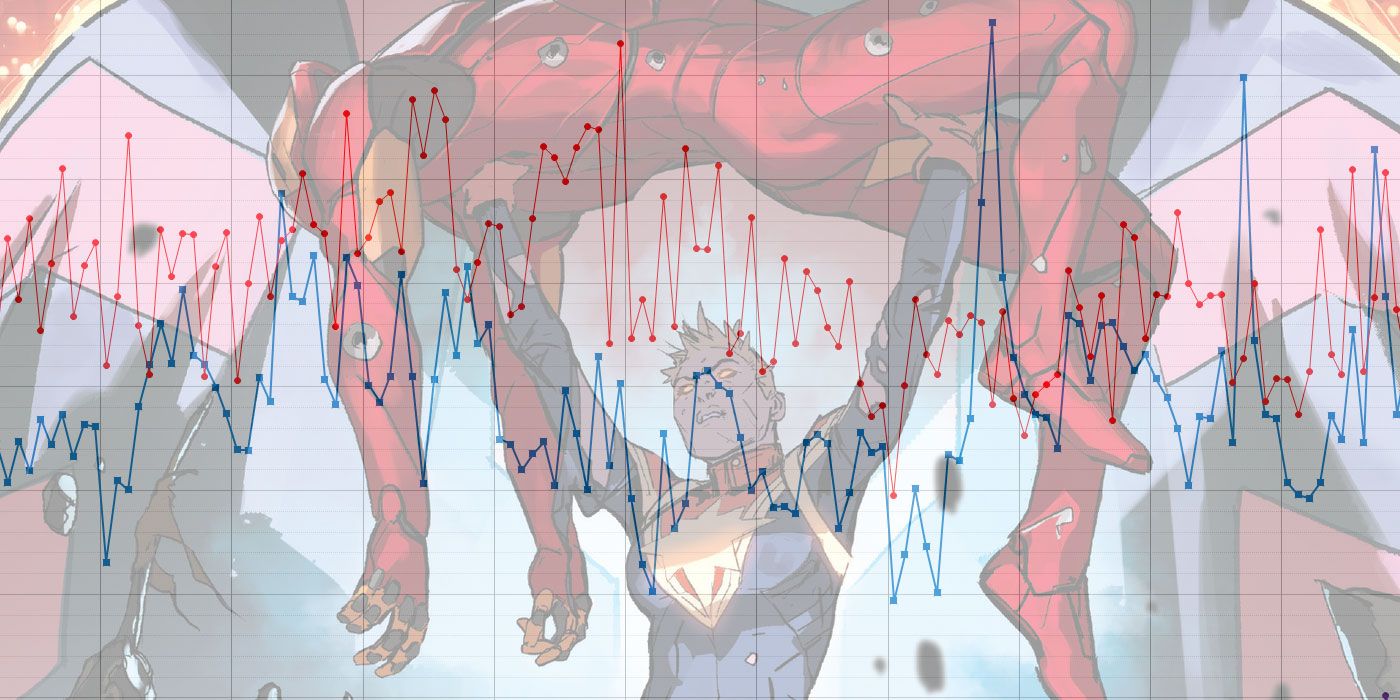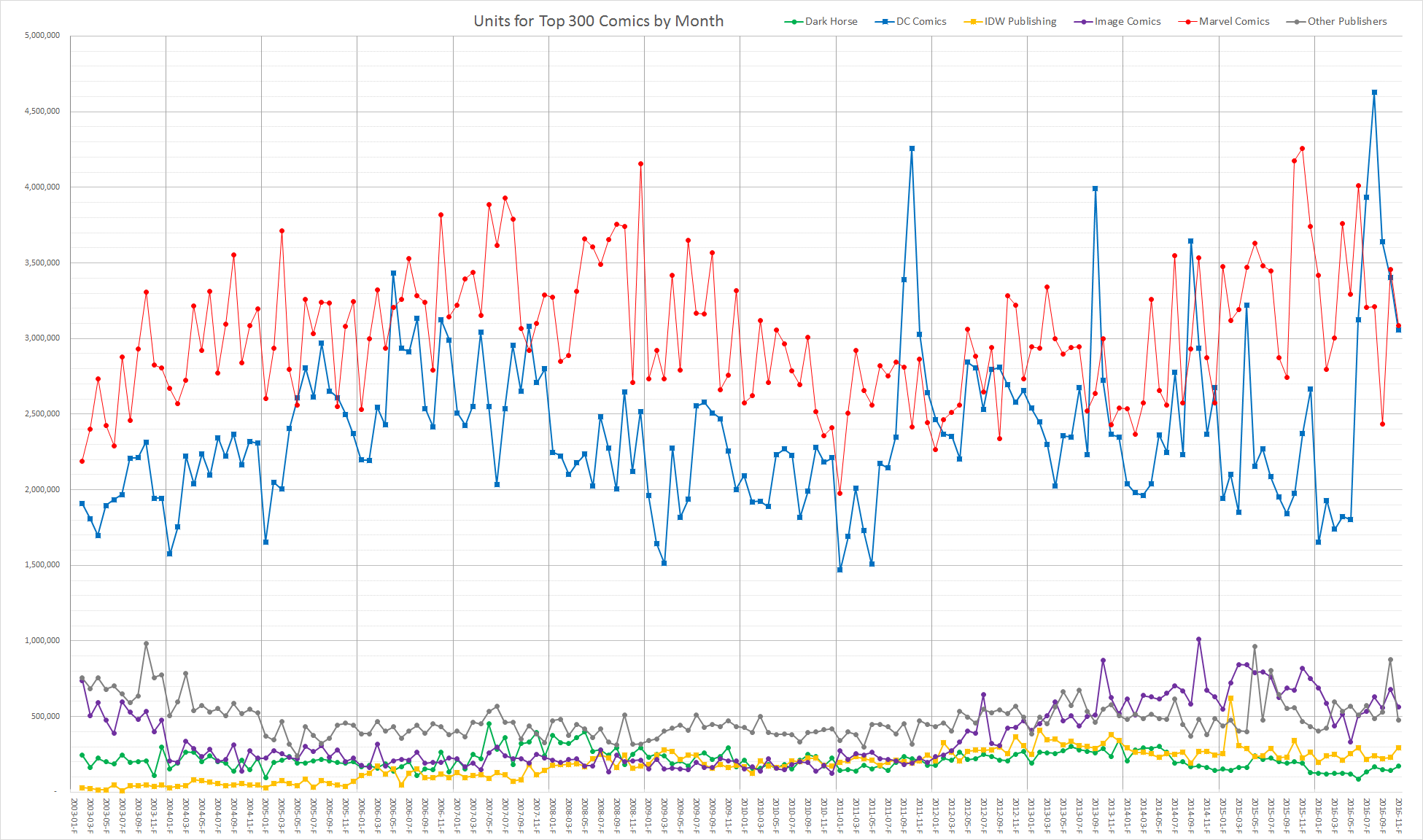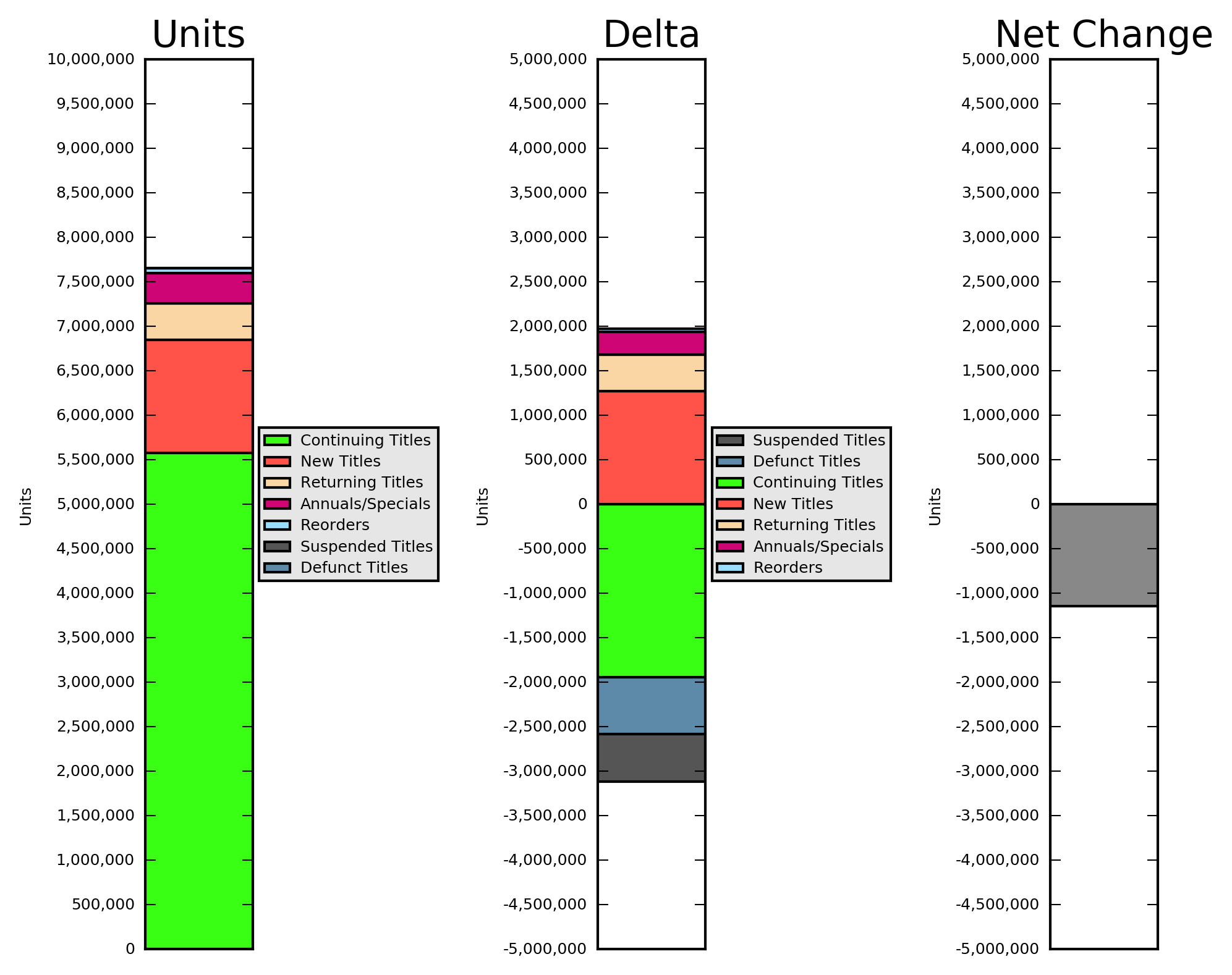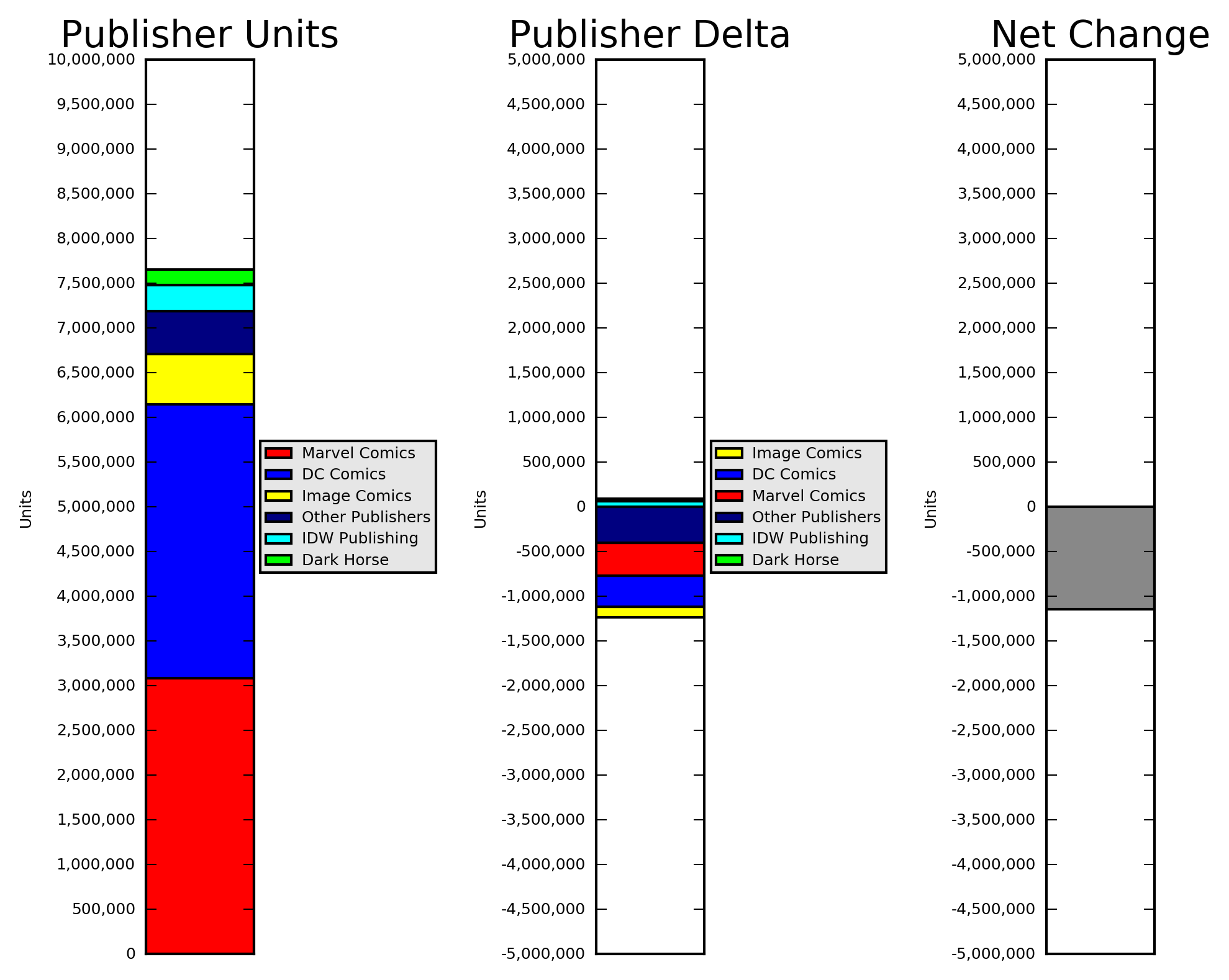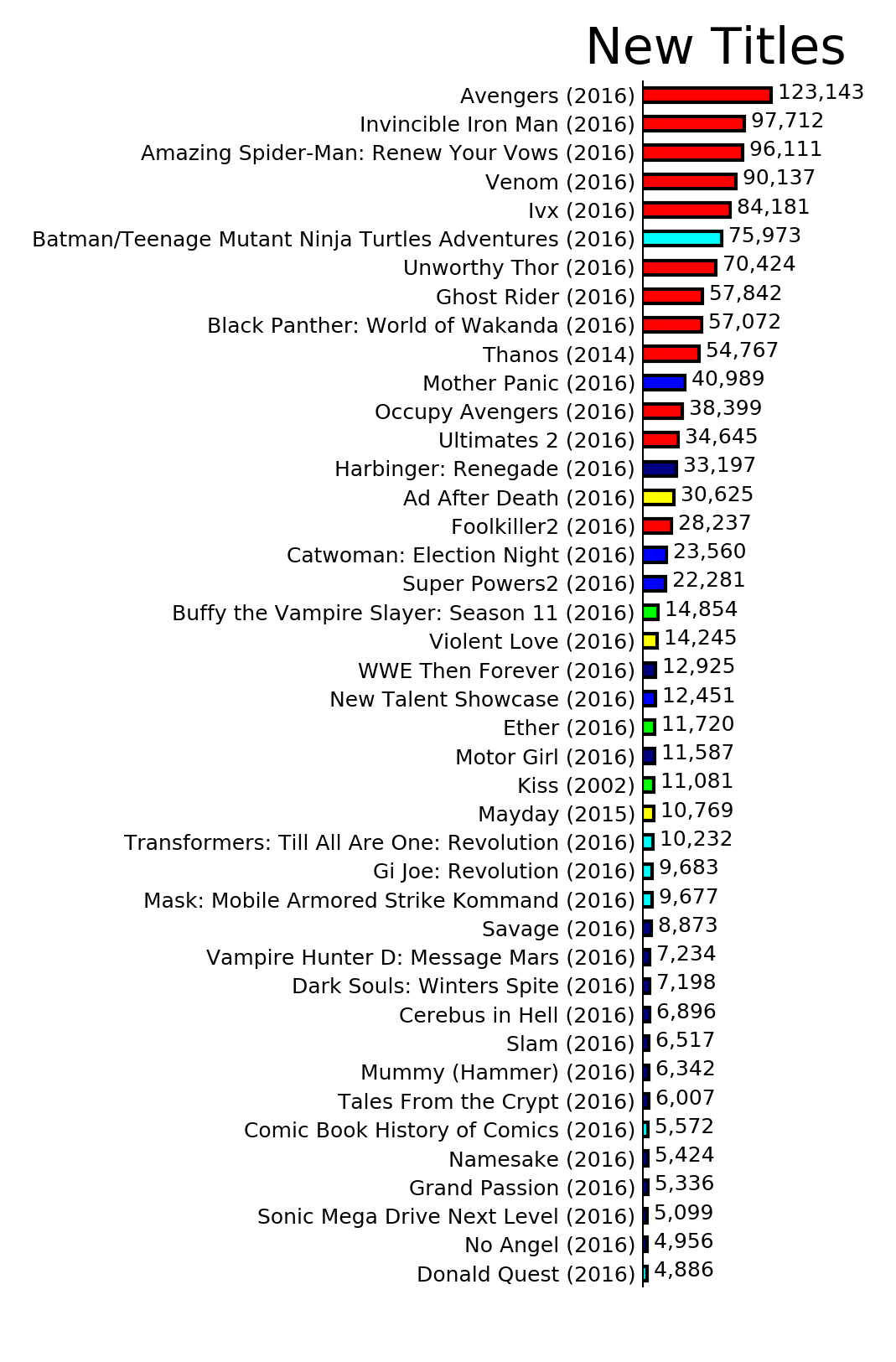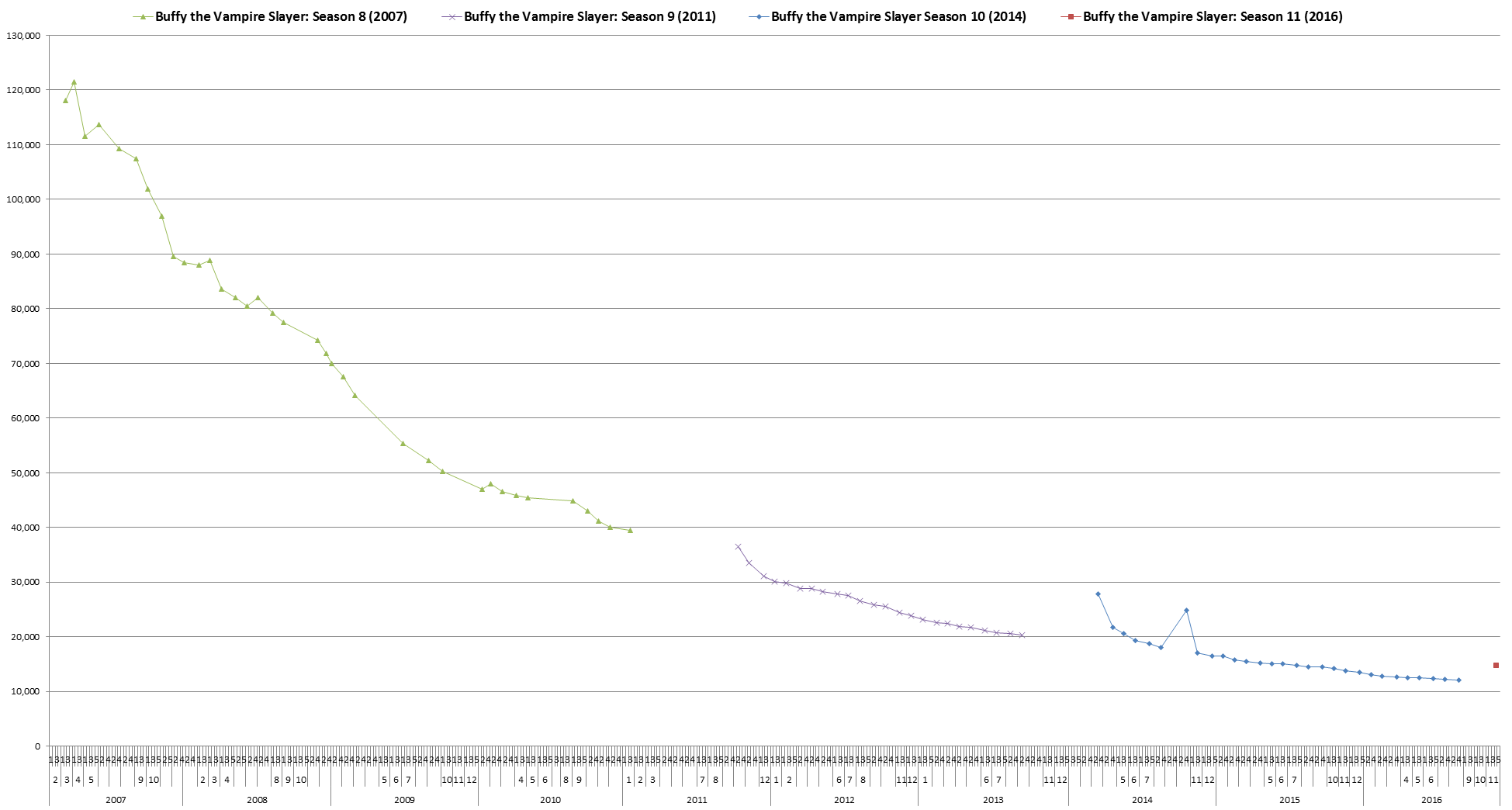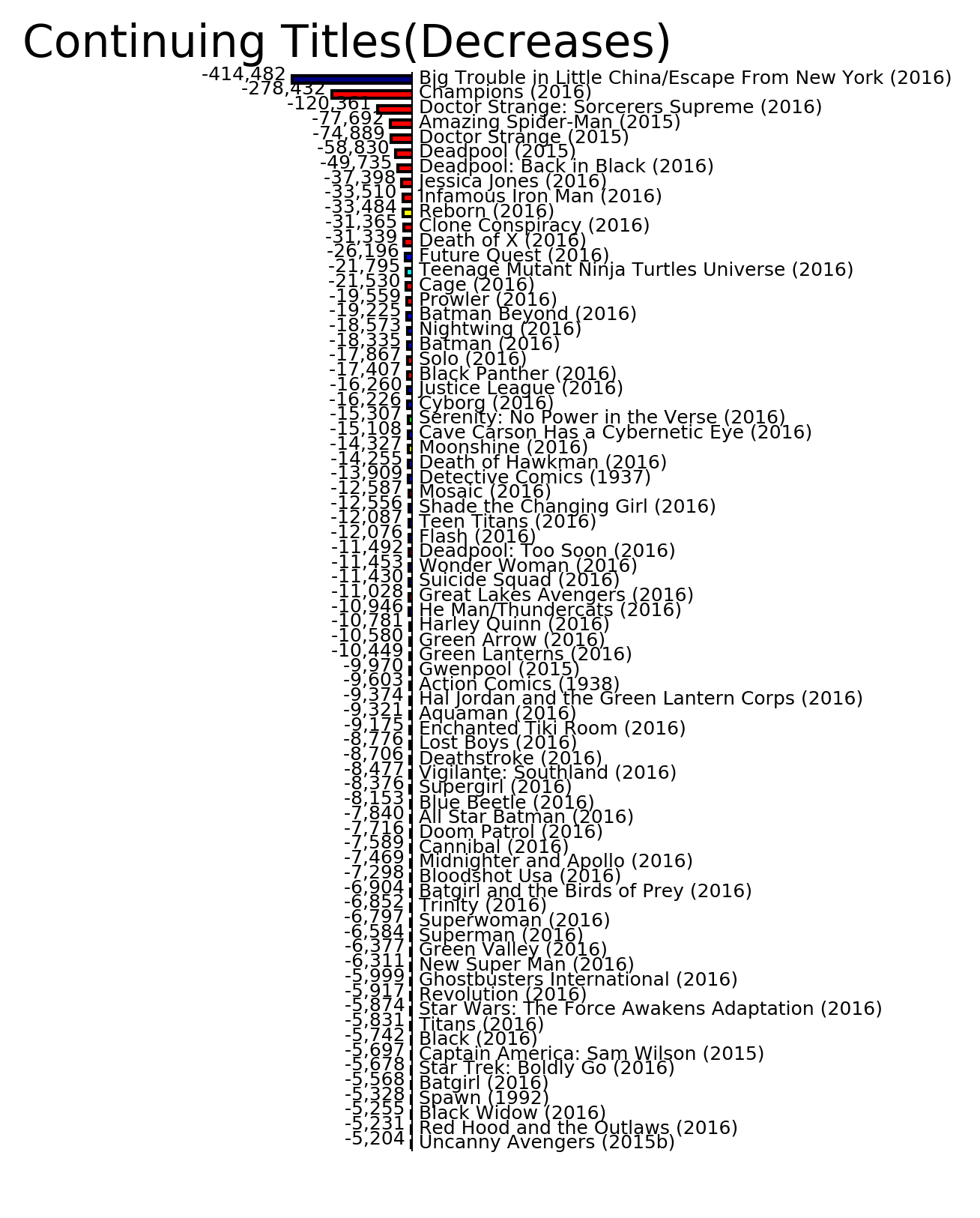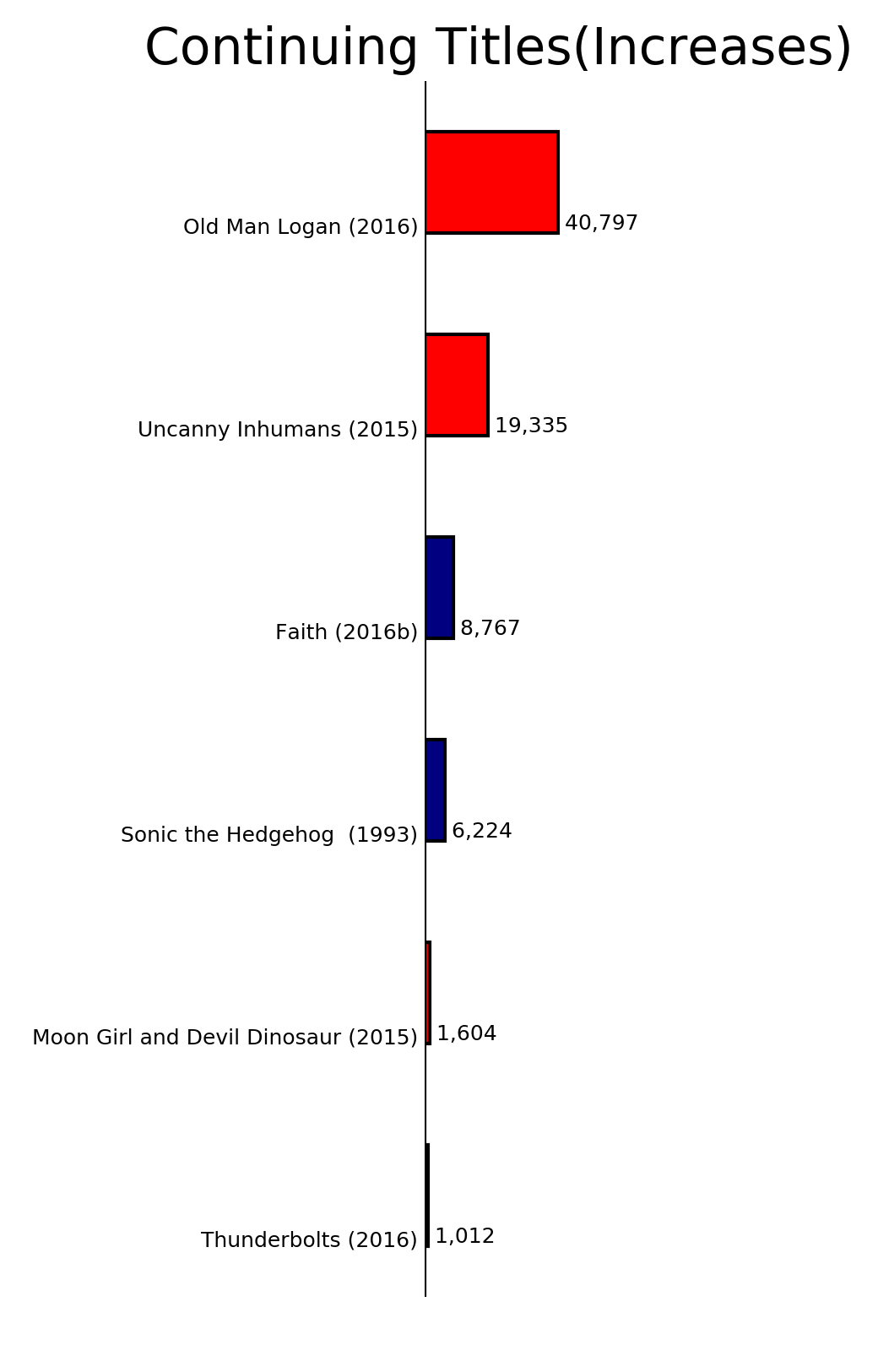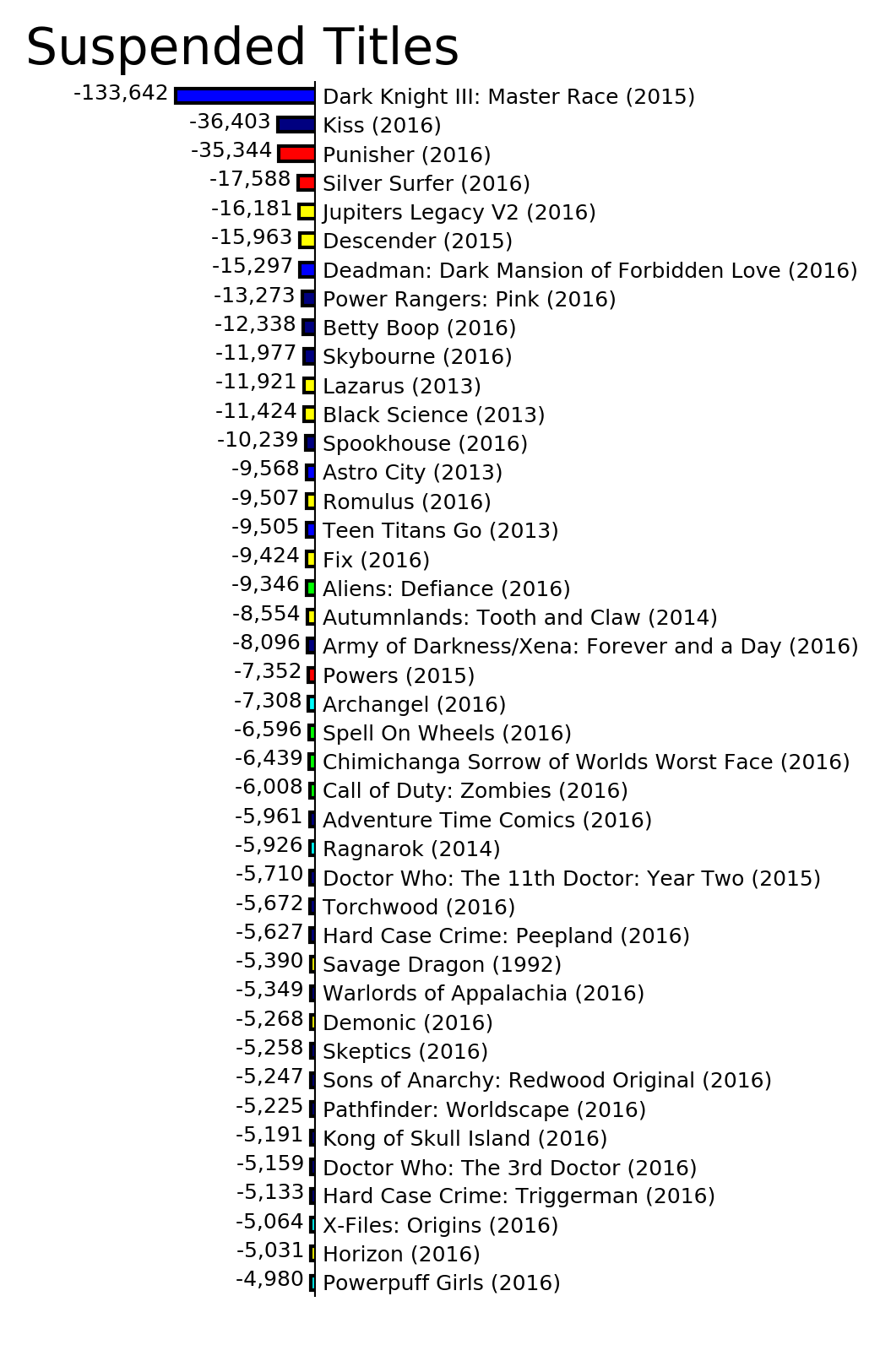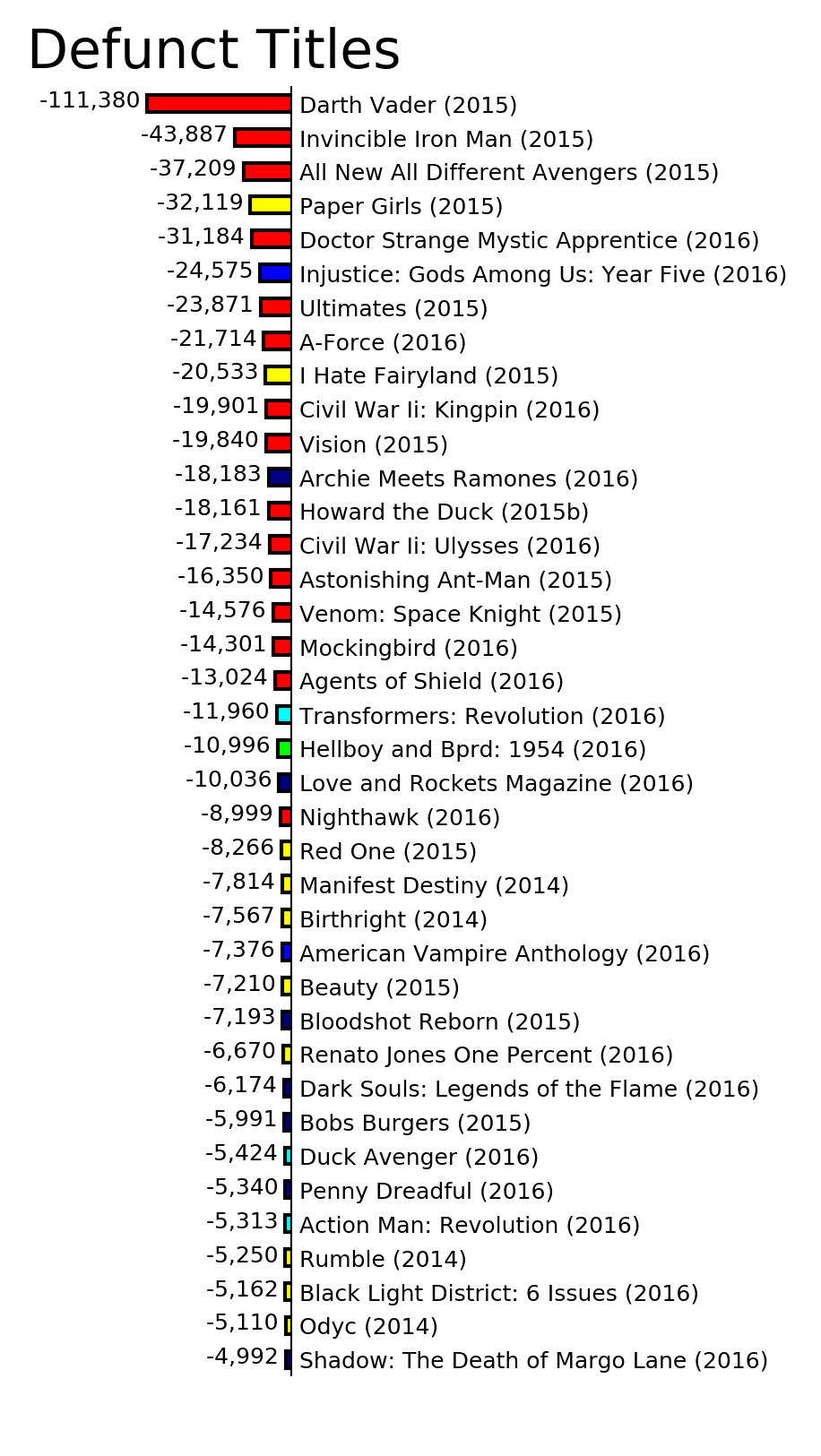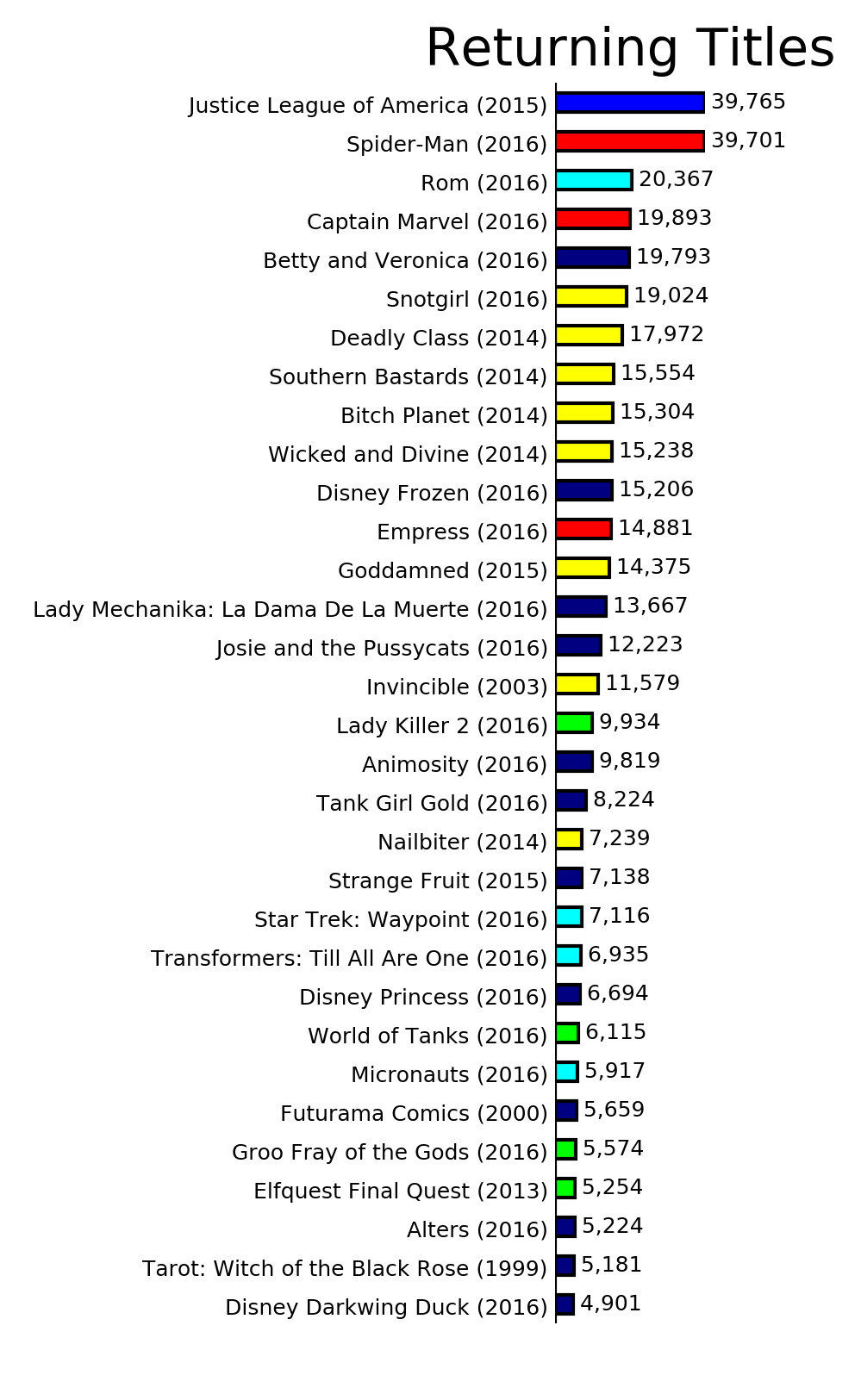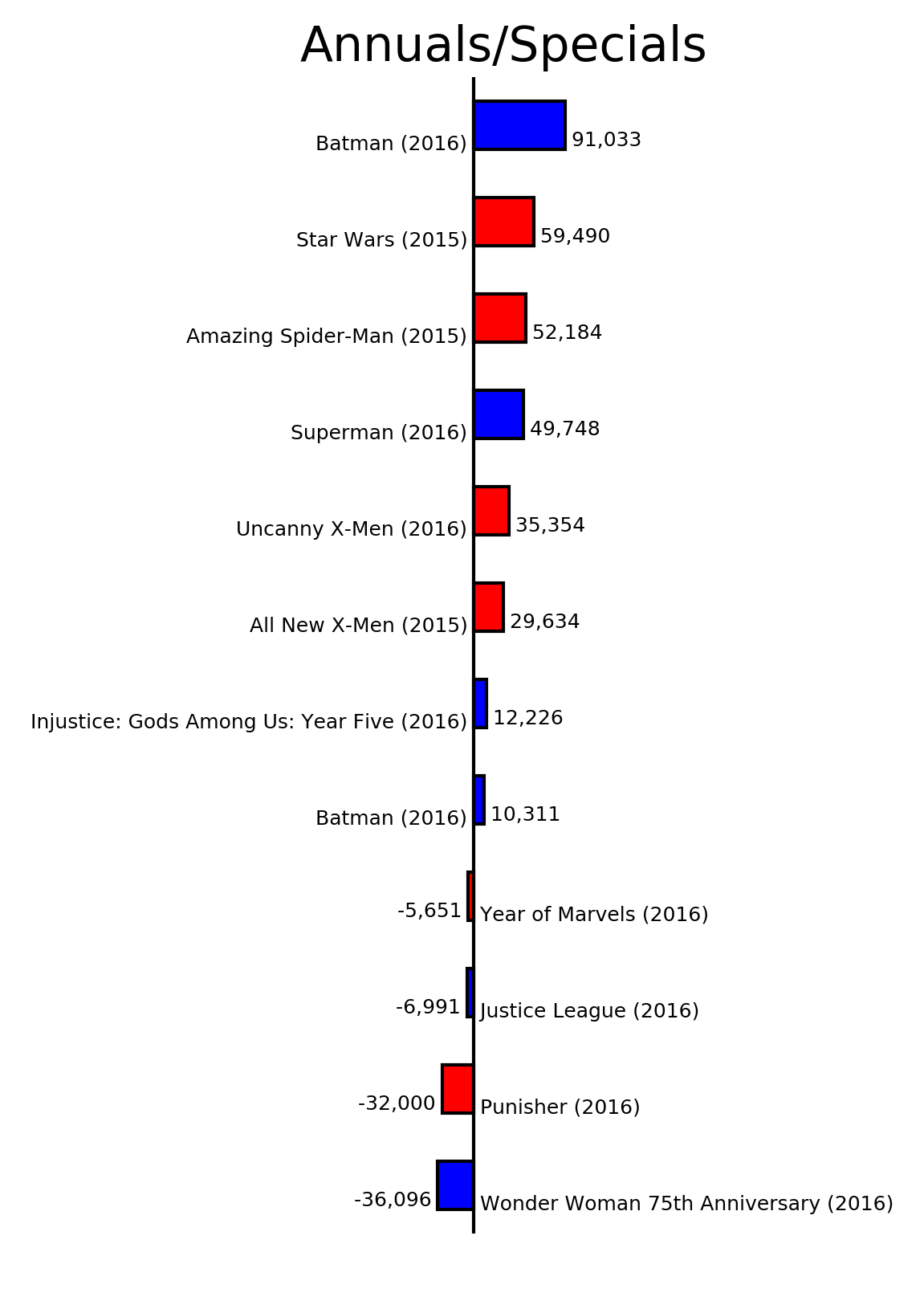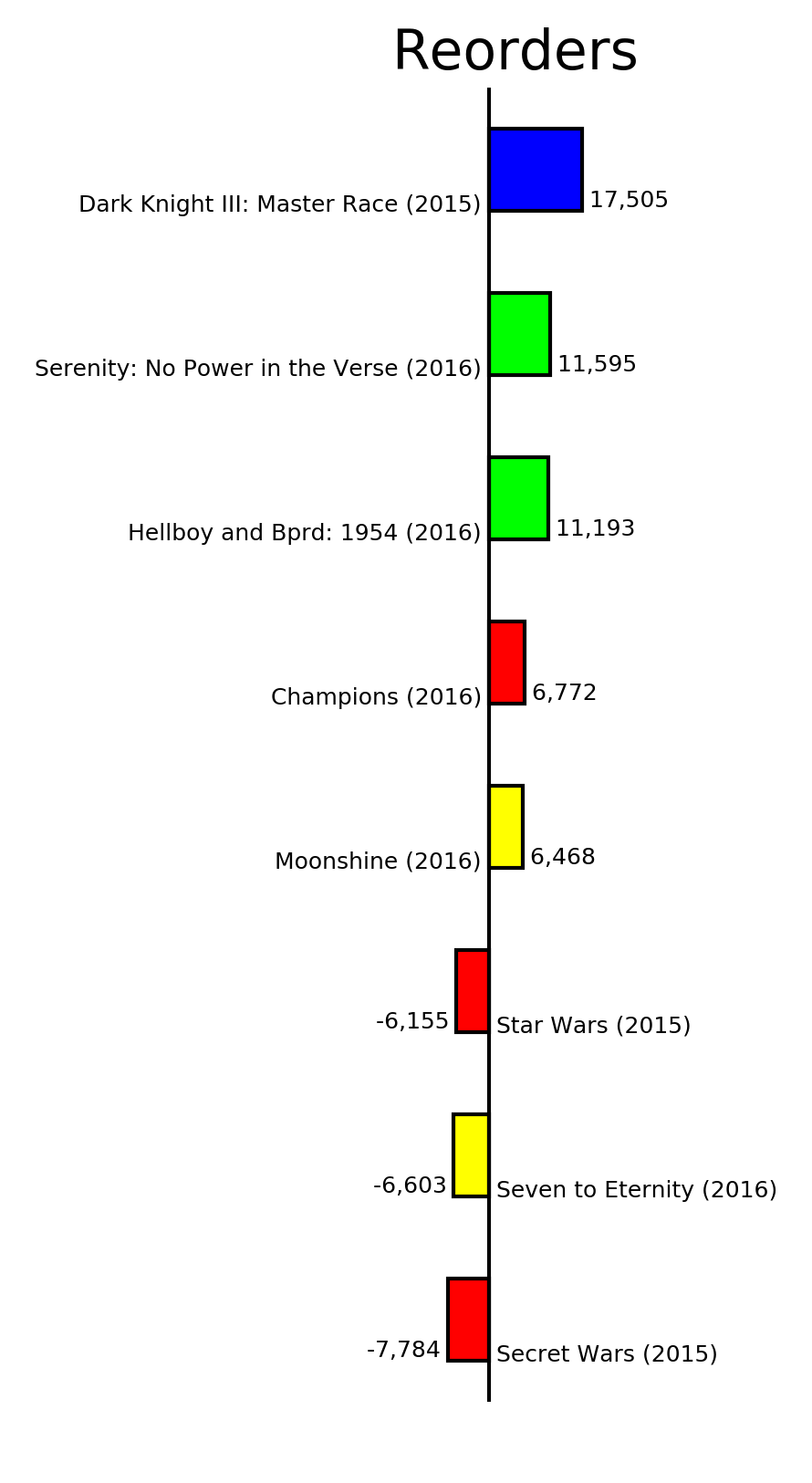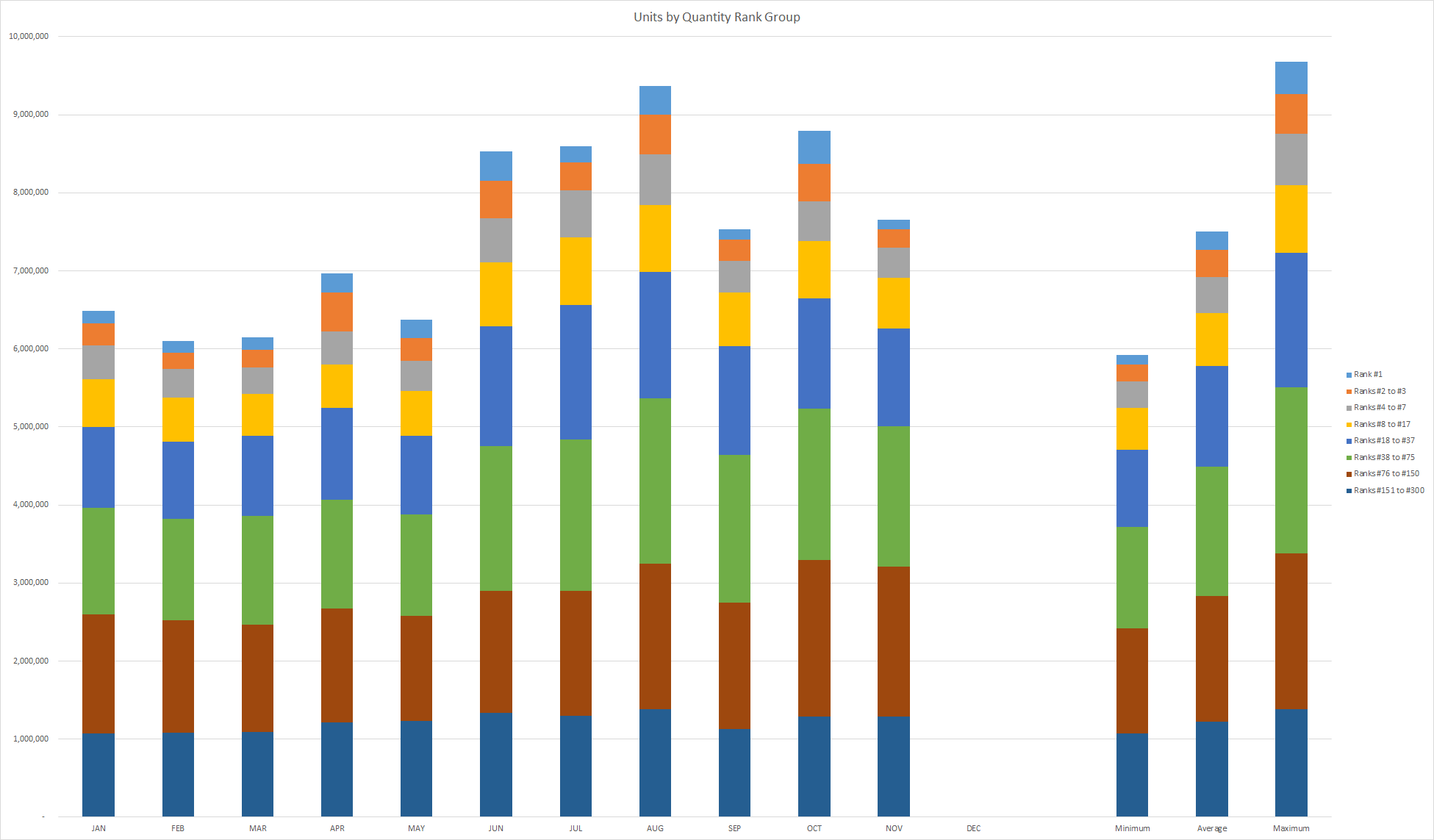November 2016 had 7,650,774 units in the top 300 comics list, a drop of 1,142,943 units from last month. It was another tight race between Marvel and DC. Marvel placed 3,086,778 units in the top 300 comics list while DC placed 3,058,190 units. The difference of 28,588 units sets a new recorder for the narrowest gaps between the two publishers breaking the one of 52,223 units set last month. Close competition between Marvel and DC can be a good thing, particularly if in increases the overall interest in comics which can benefit the other publishers. Rebirth has vastly improved how DC has been doing, which could translate into a renewed interest in comics overall.
Most of the units and most of the losses come from continuing titles, series which shipped last month and this month and should be the bedrock of comic book sales. But, as we've consistently seen over the years, ongoing title lose sales over time. Sometime we also see sharp drops in sales on the second issue of particular titles due to the sales of the first issue being inflated by various promotional tactics. The sales of new titles needs to overcome the drop in continuing titles for a month-to-month increase. In November, that didn't happen, partially because there were no new titles launching with stellar sales, and partially because of titles launching with unsustainably high sales in October, resulting in large second issue drops.
The first bar chart is the unit sales by category. The second is the month-to-month change in sales for the categories with the largest segments closest to the zero point on the y axis in either direction. The third chart is the net change in sales from last month.
If we look at the sales of the top 300 comics by publisher, we see Marvel and DC are the bulk of the sales, which shouldn't surprise anyone. The other three premiere publishers contribute a visible amount to the sales of the top 300 comics. The rest of the publishers combined have a noticeable but relatively minor impact on the top 300 comics but sell a number of other items below the radar of the top 300 comics list. Ironically, these smaller publishers offer the largest growth opportunity for the industry but at the highest risk. Just a single unsold copy of a small press title can wipe out possible profit for a retailer which only orders a handful of copies. This encourages conservative ordering of these titles and limits potential sales.
The horizontal bar charts below are color coded by publisher in accordance to the the titles on the horizontal bar charts by publisher. Marvel titles are in red, DC in blue, IDW in cyan, Image in yellow, Dark Horse in green and the other publishers in purple. We can see that the other publishers lost more sales than either Marvel or DC. This would have been an increase of 13,439 units if not for the 414,482 unit loss on "Big Trouble in Little China/Escape From New York".
New titles added 1,268,859 units to the list. New titles from Marvel accounted for 832,670 unit which is about 65.62% of the total units for this category.
"Avengers" #1 launched the new volume with 81,885 units. Marvel is doing another embedded miniseries which began with "Avengers" #1.1 which sold 41,258 units. The combined sales made "Avengers" the new title with the most units sold during the month. Most of the best selling new titles launched in November were from Marvel. A few of the items on this list of new titles are actually one-shots like "Catwoman: Election Night" and "New Talent Showcase" both of which are from DC.
"WWE Then Forever" #1 from BOOM! Studios launched with 12,925 units. The art looks great and BOOM! Studios seems to have a solid game plan for the franchise. We'll see if it turns out to be another successful license like "Mighty Morphin Power Rangers."
"Buffy the Vampire Slayer: Season 11" #1 launched with 14,854 units. For comparison, "Buffy the Vampire Slayer: Season 10" #1 sold 27,850 units, "Buffy the Vampire Slayer: Season 9" #1 sold 42,944 units and "Buffy the Vampire Slayer: Season 8" #1 launched the at 109,900 units.
The sales level for "Buffy the Vampire Slayer: Season 11" #1 makes sense given how long the comics have been continuing the television show. The property started strong but the have have dropped over the years. Each new volume essentially continued the sales trend from the previous volume. Sometimes the first issue of a new volume gets a bit of a sales bump which is quickly lost.
This next chart is filtered to drops over 10,000 units:
In most months, the majority of titles fall into the category of continuing titles which dropped in sales from the previous month. November 2016 was no exception. There were 174 continuing titles which dropped in sales to a total of 2,023,953 units. Marvel accounted for 1,001,620 of those units, DC another 424,385 units, BOOM! Studios 415,756 units and the other publishers combined accounted for the remaining 182,192 units.
The second issue drop on "Big Trouble in Little China/Escape From New York" was 98.31% going from 421,625 units on the first issue to just 7,143 units on the second. The first issue was included in LootCrate last month and had a tiered incentive cover schema. That drop was the fourth largest behind the 857,077 unit loss on "Star Wars" #2, the 486,350 unit loss on "Orphan Black" #2 and the 421,881 unit loss on "Amazing Spider-Man" #2. "Orphan Black" #1 was also included in a LootCrate. The first issues of "Star Wars" and "Amazing Spider-Man" has numerous incentive covers.
Given that it would take slightly over 58 issue at the sales of "Big Trouble in Little China/Escape From New York" #2 to equal the sales of the first issue, it is completely understandable why publishers use the sales gimmick they do. These tactics work and can bring in a lot of money. In this cases like this, the sales of the first issue can eclipse the sales of the rest of the series combined. Results like that are hard to argue with. Cover gimmicks and inclusion in subscription boxes are successful tactics for selling an issue. Those tactics do little, if anything, to sell the title beyond the particular issue. These tactics turn the first issue in the inverse of a loss-leader. Instead of pricing an item low to get people into the store with the hope they will buy other items, first issues with incentive covers and other sales gimmicks can make the first issue profitable enough to help sustain the rest of the series.
"Champions" #2 dropped 85.15% from the unsustainable 334,937 units on the first issue to a much more realistic 49,733 units. This is a reasonable sales level for this sort of title.
"Doctor Strange: Sorcerers Supreme" #2 dropped 80.40% from the 149,710 units for the first issue down to 29,349 units. Doctor Strange is a character that has struggled at times to sustain a solo title. The second title is an attempt to leverage the increased visibility of the character caused by the movie. To suggest the title won't last past a second six issue arc is pointless. Few Marvel titles last that long these days. The question is if this series will get replaced with another secondary Doctor Strange title when it does end. That might depend more on the line up of future Marvel movies than on the comic book sales.
The list of continuing titles increasing in sales is virtually always a shorter list:
Only a dozen titles increased in sales in November over October. "Old Man Logan" topped the list with 40,797 units because two issues shipped in November versus the single issue shipped in October. "Uncanny Inhumans" and "Sonic the Hedgehog" also shipped two issues in November versus the single issue for each title in October. "Faith," on the other hand, actually went up in sales. "Faith" #5 was an election special featuring an appearance by Hillary Clinton. The total gain from these continuing titles which increased in sales was 79,821 units. Removing the titles which shipped twice in November and only once in October and the total drops to 13,465 units.
This imbalance between the decline on most continuing titles and the merge increases in sales on the few titles which do increase is why I think the biggest thing that can be done to increase sales over time is a focus on reader retention. There is an acquisition cost for each reader of a title. Some level of marketing is needed to get turn potential readers into actual readers. The return on that investment increases the longer readers stay on titles. If the decline in sales could be cut by 10%, that would have resulted in an additional 202,395 units in sales in November. While that might not seem like a lot, it is nearly three times the increase in sales seen on the dozen titles which went up in sales in November. Keep in mind a quarter of those titles had to ship a second issue in November to increase in sales.
"Dark Knight III: The Master Race" was one of a number of titles which shipped in October but not November. An estimated 530,484 units from October failed to translate into sales in November due to the titles not shipping. November had five shipping weeks so there was the opportunity for more titles to ship than in a four week month. The majority of the suspended titles resulted in losses of under 15,000 each units which total up to a smaller loss than the seven suspended titles over 15,000 units.
I mentioned last month Marvel had a number of titles which were about to end. A number of them concluded in November resulting in 411,631 units in November for Marvel which can't roll over into October. The roll over from month to month never happens at 100% given the standard attrition in sales most titles have. Regardless, sales on a title end when the title ends. Of course, Marvel has replacement titles ready to launch in short order. The rest of the publishers accounted for around 229,254 units evaporating due to ending titles.
"Justice League of America" and "Spider-Man" both returned to the list after not shipping in October. The total of 411,466 units for the returning titles fails to compensate for the 530,484 units lost from suspended titles resulting in a net loss of 119,018 units between October and November due to which titles shipped from month to month.
"Betty and Veronica" #2 returned to the list in November with 19,793 units, a drop of 72.06% from the first issue sales of 70,829 units for the first issue. "Josie and the Pussycats" #2 returned to the list with 12,223 units, down 57.51% from the first issue sales of 28,769 units. Even with the drops and sales attrition on the rebooted Archie titles, the reboot seems to have been a clear success.
More annuals and specials shipped in November with stronger sales than was the case in October. Marvel and DC tend to fill fifth shipping weeks of a month with annuals. The result in an increase this month of around 259,242 units and a likely decrease in this category next month.
November had slightly more reorder activity than October but neither month had a significant amount of reorder activity.
Finally, here is a look at how the month compares to the other months this year by quantity rank groups:
The top group is the best-selling item and each group after that is roughly twice the number of items as the previous group with the last group representing the bottom half of the top 300 comics list. The last three stacks are the lowest sales for each item, the average sales and the best sales for each group over the course of this year. As you can see, November 2016 was close to an average month for 2016.

